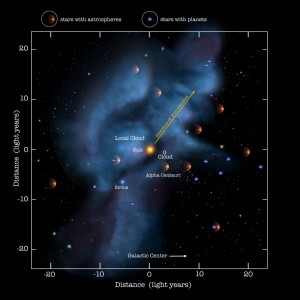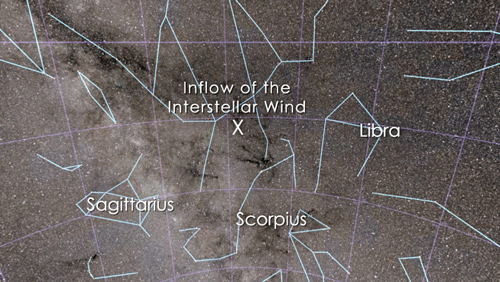Data from NASA’s Interstellar Boundary Explorer spacecraft reveal that neutral interstellar atoms are flowing into the solar system from a different direction than previously observed.
Interstellar atoms flow past the Earth as the solar system passes through the surrounding interstellar cloud at 23 kilometers per second (50,000 miles per hour). The latest IBEX measurements of the interstellar wind direction were found to differ from those made by the Ulysses spacecraft in the 1990s. That difference led the IBEX team to compare the IBEX measurements to data gathered by 11 spacecraft between 1972 and 2011. Statistical testing of the Earth-orbiting and interplanetary spacecraft data showed that, over the past 40 years, the longitude of the interstellar helium wind has changed by four to nine degrees.

The solar system moves through a local galactic cloud at a speed of 50,000 miles per hour, driving an interstellar wind of particles, which can be measured by Earth-orbiting or interplanetary spacecraft. Image courtesy of NASA/Adler/UChicago/Wesleyan (Click image to enlarge)
“We concluded it’s highly likely that the direction of the interstellar wind has changed over the past 40 years. It’s also highly unlikely that the direction of the interstellar helium wind has remained constant,” said Priscilla Frisch, lead author of the study and a senior scientist in Astronomy & Astrophysics at the University of Chicago.
“We think the change in wind direction could be explained by turbulence in the interstellar cloud around the sun,” she said.
The spacecraft data used for this study were gathered using three methods to measure the neutral interstellar helium wind direction: IBEX and Ulysses provided direct in situ measurements of the neutral wind. The earliest measurements from the 1970s used fluorescence of solar extreme ultraviolet radiation of the helium atoms near the Sun. Measurements also were included of the helium flow direction from “pickup ions”—neutral particles in the solar system that become ionized near the sun and join the solar wind.
“This result is really stunning,” said Dave McComas, IBEX principal investigator, assistant vice president of the Space Science and Engineering Division at Southwest Research Institute, and an author on the paper. “Previously we thought the very local interstellar medium was very constant, but these results show just how dynamic the solar system’s interaction is.”

From Earth’s perspective, the interstellar wind flows in from a point just above the constellation Scorpius. Results from 11 spacecraft over 40 years show that the exact direction has changed some 4 to 9 degrees since the 1970s. Image courtesy of NASA/Goddard Space Flight Center
The paper, “Decades-long Changes of the Interstellar Wind Through Our Solar System,” appears in the Aug. 6 edition of Science.
IBEX is one of NASA’s series of low-cost, rapidly developed Small Explorer space missions. Southwest Research Institute in San Antonio leads the IBEX mission with teams of national and international partners. NASA’s Goddard Space Flight Center in Greenbelt, Md., manages the Explorers Program for NASA’s Science Mission Directorate in Washington, D.C.
—Adapted from a Southwest Research Institute news story.
– By Maria Martinez
*Source: The University of Chicago
